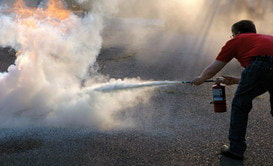 A fire in the home can create a level of panic that is unmatched by virtually any other event. Unfortunately, what starts out as a very small fire can quickly become an inferno that can cause serious injury and death. It’s important to understand that trying to fight a small fire on your own could actually make the problem worse if it’s not done correctly. We want to help you be safe by explaining how to put out different types of fires. Before we get to firefighting techniques, remember that it’s never wise to put yourself in danger just to put out a fire. Your home and possessions can be replaced; you cannot. If a fire in your home causes you to feel threatened – whether or not you can fight the fire by yourself – protect yourself by calling 911. Cooking Fires: Next to fires caused by careless smoking, cooking fires are the second most common in the United States. These kinds of fires can occur in the oven or on top of the stove. Here's what you need to know:
Electrical Fires: Electrical fires can be caused by overloaded sockets, frayed wires, or equipment malfunction. As with grease fires, do not attempt to put out an electrical fire using water. Water conducts electricity, exposing you to the risk of electrical shock. To put out an electrical fire, unplug the device if possible. Then smother the flames using a blanket or piece of heavy clothing. If you have a fire extinguisher in the house, it offers you another option. As with kitchen fires, it’s easier to stop electrical fires before they get started. Routinely check cords for fraying or breaks. Also, avoid using extension cords for anything other than temporary power. Storage Area Fires: A fire in a storage area can be caused by any number of things. For example, oil soaked rags can easily combust if exposed to even the smallest of sparks. Other causes can include improperly stored gasoline, charcoal lighter fluid, and household solvents. Type B fire extinguishers are your best bet for putting out fires related to petroleum products and solvents. Type A fire extinguishers work well for paper and similar items. In the absence of a fire extinguisher, smother the flames with a blanket or a heavy piece of clothing. Natural Gas Fires: The most dangerous source of a house fire is natural gas. Turn off the gas supply and call the fire department immediately. If you cannot get to the shutoff, try to smother the flames with a heavy carpet or blanket. Even if you are successful in putting out the flames however, exit the home immediately. Leaking gas always poses a risk of explosion. Chimney Fires: Any home with a fireplace or wood-burning stove can be susceptible to chimney fires caused by creosote buildup. Once a fire erupts in the chimney, it is already too late to fight it on your own. Get out of the house and call 911. Do not attempt to go up on your roof and douse the flames with a garden hose. Chimney fires can grow very quickly to engulf the entire structure. A fire in your home is likely to be a major crisis, but you can reduce the chances of injury and property loss by installing a home security system with fire monitoring from One-Stop Communications. We would welcome the chance to tell you more about how to make your home safer in the event of a fire. Source: Comments are closed.
|
Archives
March 2024
|

 RSS Feed
RSS Feed
